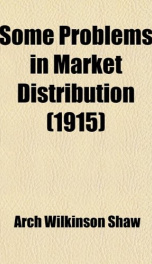some problems in market distribution

Purchase of this book includes free trial access to www.million-books.com where you can read more than a million books for free. This is an OCR edition with typos. Excerpt from book: The working of this policy, especially as to bringing new consumers into the market, is shown graphically in Chart I. Chart I Selling at the Market Minus This chart attempts to show graphically the operation on the demand side of the market of the price policy termed ' selling at the market minus." On the ordinate ox is laid off a scale of prices for the commodity. On the abscissa ay are laid off the number of purchasers. The arc LAI shows the number of purchasers at a given price, growing fewer as the price increases and greater as the price decreases. Now if oa represents the prevailing market price for the commodity, and oc the number of purchasers at that price, it is apparent that if the price is reduced from oa to oa', new consumers will be brought into the market and the number of purchasers at the price oa' will be oc', a number greater than oc. It is somewhat in this fashion that the policy of selling at the market minus operates, but the chart does not indicate the important element that other producers are selling at a higher level, and hence customers are attracted from them, as well as new customers brought into the market. (2) Selling at the market has been the policy perhaps most characteristic of our scheme of distribution during the period when the stress was on production. It is still a common policy in the marketing of staple goods. This policy consists briefly in the acceptance of the market price existing for the commodity as a fixed condition. The producer does not seek toattract purchasers by maintaining a price level somewhat lower than that at which other producers of the same commodity are willing to sell, nor does he attempt to establish his commodity upon a new and higher price level as a distinct commodity. He recognizes the market ...
Users who have this book
Users who want this book
What readers are saying
What do you think? Write your own comment on this book!
write a commentif you like some problems in market distribution try:
Other books by this author
Do you want to read a book that interests you? It’s EASY!
Create an account and send a request for reading to other users on the Webpage of the book!


